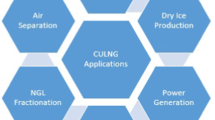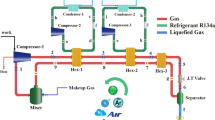Abstract
The liquefied natural gas, LNG, possesses cold energy that can be put to use in the regasification process for various purposes. In this paper the proposed configuration consists of a Rankine cycle, an Organic Rankine cycle, and a Stirling cycle. The LNG cold energy and the enthalpy of the flue gas, which are the product of the combustion chamber, are used as the heat sink and the heat source of the mentioned cycles, respectively. Thermal and exergy analysis are conducted on the novel cycle. A parametric study is also carried out and finally the optimum working condition for the plant is obtained. The results indicate that in an optimum condition the thermal and exergy efficiencies can reach up to 53.51% and 47.43%, respectively. The parametric analysis shows that the pressure ratio of the Rankine cycle’s turbine and the Brayton cycle’s compressor can have a significant effect on the overall performance of the proposed plant. The overall result from the analysis suggests that implementing the three mentioned cycles (Organic Rankine Cycle, Stirling cycle and Rankine cycle) that employ the LNG cold energy, can lead to 43% increase in the output power in comparison with utilizing the Brayton cycle alone.














Similar content being viewed by others
Abbreviations
- \( \dot{E} \) :
-
exergy rate (kW).
- e :
-
specific exergy (kJ/kg).
- h :
-
specific enthalpy (kJ/kg).
- \( \dot{m} \) :
-
mass flow rate (kg/s).
- P :
-
pressure (MPa).
- \( \dot{q} \) :
-
heat transfer rate (kW).
- s :
-
specific entropy (kJ/kg.K).
- T :
-
temperature (K).
- \( \dot{w} \) :
-
power (kW)x
cryogenic power coefficient (−).
- η :
-
efficiency (−).
- λ :
-
air-fuel ratio (−).
- C :
-
compressor
- T :
-
turbine
- HE :
-
heat exchanger
- P :
-
pump
- Comb :
-
Combustor
- 0 :
-
ambient
- ph :
-
physical
- ch :
-
chemical
- in :
-
inlet
- out :
-
outlet
References
Mokhatab S, Mak JY, Valappil JV, Wood DA (2013) Handbook of liquefied natural gas: Gulf Professional Publishing
Mobil E (2015) The Outlook of Energy: A View to 2040, 2012, Website: http://www.exxonmobil. com/corporate/files/news_pub_eo. pdf [accessed 20.09. 13]
Kanbur BB, Xiang L, Dubey S, Choo FH, Duan F (2017) Cold utilization systems of LNG: A review. Renew Sust Energ Rev 79:1171–1188
Miyazaki T, Kang Y, Akisawa A, Kashiwagi T (2000) A combined power cycle using refuse incineration and LNG cold energy. Energy 25:639–655
Mosaffa A, Mokarram NH, Farshi LG (2017) Thermoeconomic analysis of a new combination of ammonia/water power generation cycle with GT-MHR cycle and LNG cryogenic exergy. Appl Therm Eng 124:1343–1353
Kim KH, Kim KC (2014) Thermodynamic performance analysis of a combined power cycle using low grade heat source and LNG cold energy. Appl Therm Eng 70:50–60
Mehrpooya M, Sharifzadeh MMM, Rosen MA (2015) Optimum design and exergy analysis of a novel cryogenic air separation process with LNG (liquefied natural gas) cold energy utilization. Energy 90:2047–2069
Xie C, Zhang L, Liu Y, Lv Q, Ruan G, Hosseini SS (2017) A direct contact type ice generator for seawater freezing desalination using LNG cold energy, Desalination
Li P, Li J, Pei G, Munir A, Ji J (2016) A cascade organic Rankine cycle power generation system using hybrid solar energy and liquefied natural gas. Sol Energy 127:136–146
García RF, Carril JC, Gomez JR, Gomez MR (2016) Combined cascaded Rankine and direct expander based power units using LNG (liquefied natural gas) cold as heat sink in LNG regasification. Energy 105:16–24
He S, Chang H, Zhang X, Shu S, Duan C (2015) Working fluid selection for an Organic Rankine Cycle utilizing high and low temperature energy of an LNG engine. Appl Therm Eng 90:579–589
Dong H, Zhao L, Zhang S, Wang A, Cai J (2013) Using cryogenic exergy of liquefied natural gas for electricity production with the Stirling cycle. Energy 63:10–18
Gómez MR, Garcia RF, Gómez JR, Carril JC (2014) Thermodynamic analysis of a Brayton cycle and Rankine cycle arranged in series exploiting the cold exergy of LNG (liquefied natural gas). Energy 66:927–937
Mehrpooya M, Sharifzadeh MMM, Rosen MA (2016) Energy and exergy analyses of a novel power cycle using the cold of LNG (liquefied natural gas) and low-temperature solar energy. Energy 95:324–345
Bao J, Lin Y, Zhang R, Zhang N, He G (2017) Strengthening power generation efficiency utilizing liquefied natural gas cold energy by a novel two-stage condensation Rankine cycle (TCRC) system. Energy Convers Manag 143:312–325
Kim K, Lee U, Kim C, Han C (2015) Design and optimization of cascade organic Rankine cycle for recovering cryogenic energy from liquefied natural gas using binary working fluid. Energy 88:304–313
Moghimi M, Khosravian M (2018) Exergy optimization for a novel combination of organic Rankine cycles, Stirling cycle and direct expander turbines, Heat and Mass Transfer, pp. 1–13
Sadaghiani MS, Ahmadi M, Mehrpooya M, Pourfayaz F, Feidt M (2018) Process development and thermodynamic analysis of a novel power generation plant driven by geothermal energy with liquefied natural gas as its heat sink. Appl Therm Eng 133:645–658
Sun Z, Lai J, Wang S, Wang T (2018) Thermodynamic optimization and comparative study of different ORC configurations utilizing the exergies of LNG and low grade heat of different temperatures. Energy 147:688–700
Sadreddini A, Ashjari MA, Fani M, Mohammadi A (2018) Thermodynamic analysis of a new cascade ORC and transcritical CO 2 cycle to recover energy from medium temperature heat source and liquefied natural gas. Energy Convers Manag 167:9–20
Bao J, Zhang R, Lin Y, Zhang N, Zhang X, He G (2018) Simultaneous optimization of system structure and working fluid for the three-stage condensation Rankine cycle utilizing LNG cold energy. Appl Therm Eng 140:120–130
Ghaebi H, Namin AS, Rostamzadeh H (2018) Exergoeconomic optimization of a novel cascade Kalina/Kalina cycle using geothermal heat source and LNG cold energy recovery. J Clean Prod 189:279–296
Badami M, Bruno JC, Coronas A, Fambri G (2018) Analysis of different combined cycles and working fluids for lng exergy recovery during regasification, Energy
Lu T, Wang K (2009) Analysis and optimization of a cascading power cycle with liquefied natural gas (LNG) cold energy recovery. Appl Therm Eng 29:1478–1484
Arsalis A, Alexandrou A (2014) Thermoeconomic modeling and exergy analysis of a decentralized liquefied natural gas-fueled combined-cooling–heating-and-power plant. J Nat Gas Sci Eng 21:209–220
Bejan A, Tsatsaronis G (1996) Thermal design and optimization. John Wiley & Sons
Feher EG (1968) The supercritical thermodynamic power cycle. Energy convers 8:85–90
Author information
Authors and Affiliations
Corresponding author
Additional information
Publisher’s note
Springer Nature remains neutral with regard to jurisdictional claims in published maps and institutional affiliations.
Rights and permissions
About this article
Cite this article
Moghimi, M., Rashidzadeh, S., Hosseinalipour, S.M. et al. Exergy and energy analysis of a novel power cycle utilizing the cold energy of liquefied natural gas. Heat Mass Transfer 55, 3327–3342 (2019). https://doi.org/10.1007/s00231-019-02660-8
Received:
Accepted:
Published:
Issue Date:
DOI: https://doi.org/10.1007/s00231-019-02660-8




